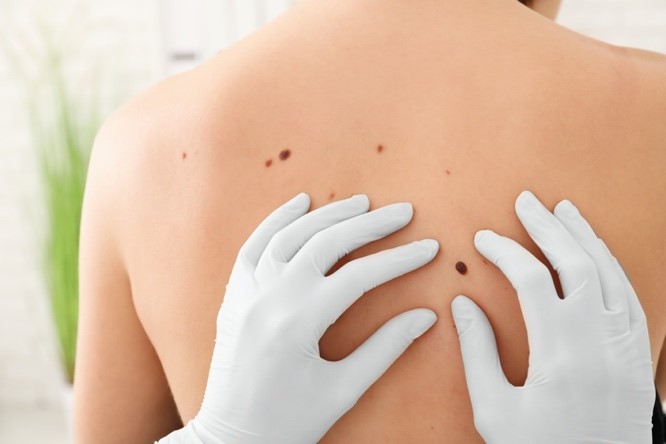Skin cancers such as Melanoma, Basal Cell Carcinoma, and Squamous Cell Carcinoma can occur on the face or other parts of the body. Often they are associated with sun damage and fair skin but not in every case. These skin cancers can be directly excised and closed or undergo a process known as Moh’s surgery where precise real-time margins are cleared by the dermatologic surgeon.
Plastic surgeons are often called in to close these defects and there are a number of types of closure and flaps and grafts that can be used for this purpose. Dr. Kim performs many of these skin cancer and Moh’s skin cancer reconstructions in both a clinic setting at his Northwestern Memorial Hospital offices, as well as in the operating room if necessary. The type of reconstruction that Dr. Kim performs will vary according to the defect location, size, and other anatomic and oncologic factors. Dr. Kim will work with dermatologists and surgical oncologists to ensure that there is a coordinated approach to the skin cancer removal and treatment to optimize the aesthetic outcome of the surgery.

10 months post op
Check out Dr. Kim’s article “Cosmetic outcomes following head and neck melanoma reconstruction: the patient’s perspective” here.
For sensitive locations of the face following skin cancer excision, Dr. Kim may use precise primary closure to approximate the tissues carefully and judiciously. For larger defects after Moh’s surgery or skin cancer removal, Dr. Kim may need to use local flaps which are tissues rotated and transposed into the defect.

3 years post op
Care has to be taken in the face to make sure that the tissue rearrangement does not overly alter the neighboring structures of the eye, nose, cheek and mouth. There is some artistry that has to be matched with the technical function of the procedure. Dr. Kim has published research on the issues related to cosmetic outcomes from these types of procedures.
On rare occasions, more complex procedures such as a forehead flap are required to reconstruct the defect. This is especially true for nasal defects. Dr. Kim performs this procedure in several stages with the end result being a natural reconstruction of the nose.

8 months post op
Additionally, there are times when Dr. Kim will take a skin graft from another part of the body and use it to cover a full-thickness defect from skin cancer excision and Moh’s surgery. This process takes a little longer to heal (4 weeks or more) and the skin color and texture will be slightly different from the native skin. However, in cases where a skin graft is used, there is often a paucity of local flap or primary closure options. These skin grafts will often be done in the operating room at Prentice Women’s Hospital or at Northwestern Memorial Hospital.
After surgery, Dr. Kim will continue to see you intermittently and employ a customized anti-scar regimen to help you optimize the appearance following Moh’s surgery or skin cancer excision.
Moh’s Before & After Compilation
Skin Cancer Reconstruction FAQs
Is Skin Cancer Reconstruction Medically Necessary?

Skin cancer reconstruction is an essential part of Mohs surgery to promote proper healing and prevent mild to severe disfigurement. Plastic surgeons are regularly involved in the skin cancer excision process to ensure an aesthetically-pleasing result. That often requires closures, flaps or skin grafts. Dr. Kim will discuss your procedure, including any aspect that may be deemed “cosmetic.”
How Do I Care for My Skin After Skin Cancer Reconstruction?
Follow your wound care instructions from Dr. Kim, which include cleansing the area and applying topical medications. Avoid light activity until you are cleared to resume your everyday tasks and be sure to keep incisions clean. Try to limit movement in the area to prevent stressing the wound and sutures.
Do I Need to Avoid Sun Exposure After Mohs Surgery and Reconstruction?
Exposing healing wounds to the sun may cause irregular pigmentation, resulting in raised, red or dark scars. Sun exposure also increases your risk of skin cancer recurrence. Avoid time in direct sunlight until your incision site has healed, and apply sunscreen to all exposed face and body areas.
Can Skin Cancer Come Back After Mohs Surgery and Reconstruction?
There is a risk for skin cancer recurrence depending on certain factors such as the size, border, growth rate and location of the tumor. However, skin cancer is less likely to come back after excision and least probable after Mohs surgery. An evaluation of the five-year recurrence rate among post-op patients who had skin cancer excision or Mohs surgery found the recurrence rate for basal cell carcinoma was 2% for excisions and 1% for Mohs surgery.
In cases where the skin tumor returns, Mohs surgery is still the preferred option. In squamous cell carcinoma, the five-year recurrence rate was 3% for Mohs and 8% for excisions. Some forms of skin cancer require additional treatment, such as radiation therapy. Follow-up appointments after Mohs surgery and skin cancer reconstruction are crucial for the early detection of new skin lesions.
How Long Is Recovery from Skin Cancer Reconstruction?

The incision site may be sore and red. You could experience some fluid drainage, and healing will continue for weeks, maybe months, depending on the extent of your procedure. How long your incision takes to heal depends on the size and location of the skin cancer and how well your recovery goes. Make sure you avoid excessive motion, swelling and abrasion in the area as you heal.
Do Skin Cancer Reconstruction Scars Go Away?
Dr. Kim makes every effort to avoid significant scarring by concealing incisions where applicable, but no surgery is without scars. Scars from skin cancer reconstruction may never fade away but will improve and blend with surrounding skin as time passes. It may take a year or longer for incision lines to lessen. Sometimes, a secondary procedure is required to refine your appearance.
Where Is the Skin Removed for a Skin Graft?
Tissues for a skin graft are typically removed from a less visible body area then moved to the treated area. A base is created using the relocated skin tissue, which reduces scarring and quickens wound healing.